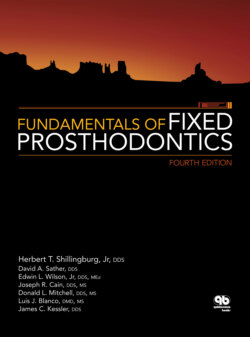Читать книгу Fundamentals of Fixed Prosthodontics - James C. Kessler - Страница 45
На сайте Литреса книга снята с продажи.
Arcon and Nonarcon Articulators
ОглавлениеThere are two basic designs used in the fabrication of articulators: arcon and nonarcon. On an arcon articulator, the condylar elements are placed on the lower member of the articulator, just as the condyles are located on the mandible. The mechanical fossae are placed on the upper member of the articulator, simulating the position of the glenoid fossae in the skull. In the case of the nonarcon articulator, the condylar paths simulating the glenoid fossae are attached to the lower member of the instrument, while the condylar elements are placed on the upper portion of the articulator.
To set the condylar inclinations on a semi-adjustable instrument, wax wafers called interocclusal records are used to transfer the terminal positions of the condyles from the skull to the instrument (see chapter 4 for the technique). These wafers are 3.0 to 5.0 mm thick so that the teeth on the maxillary and mandibular casts are separated by that distance when the condylar inclinations are set.
When the wafers are removed from an arcon articulator and the teeth are closed together, the condylar inclination will remain the same. However, when the teeth are closed on a nonarcon articulator, the inclination changes, becoming less steep (Fig 3-7). Arcon articulators have become more widely used because of their accuracy and the ease with which they disassemble to facilitate the occlusal waxing required for cast gold restorations. However, this very feature makes them unpopular for arranging denture teeth. The centric position is less easily maintained when the occlusion of all of the posterior teeth is being manipulated. Therefore, the nonarcon instrument has been more popular for the fabrication of dentures. Arcon articulators equipped with firm centric latches that prevent posterior separation will overcome many of these objections.
Fig 3-8 After the THA locator is placed, the patient is assisted in opening and closing on the THA. An arcing movement of the stylus on the side arm (A) indicates that it is not located over the THA. The side arm is adjusted so the stylus will rotate without moving during opening and closing (B). This indicates that it has been positioned over the THA.
Fig 3-9 When a precision facebow transfer is made, both side arms are adjusted so that the stylus at the end of each arm is located over the THA (arrow). A third reference point, such as the plane indicator shown here, is used.
